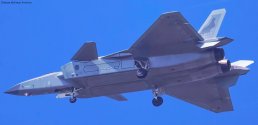You are using an out of date browser. It may not display this or other websites correctly.
You should upgrade or use an alternative browser.
You should upgrade or use an alternative browser.
J-20 5th Gen Fighter Thread VIII
- Thread starter Blitzo
- Start date
You can get ever increasing turbine inlet temperatures without changing the engine architecture just by using more heat resistant materials. It's why China has the WS-10 Pro Max Plus syndrome.Just compare the turbine inlet temperature of F100, F119 and F135. Massive difference.
No one is trying to trivialize materials but performance improvement from running the same cycle hotter and harder because you have better materials is not the same thing as innovation in design architecture. Materials that are inherently superior are very easy to swap out and essentially involve minimal risk and test burdens, which give you a way to do faster iterations in the development cycle. Furthermore the material’s own development cycle is not tied to any engine and can be iterated on quickly in parallel. The point is material improvements are very different from the sort of longer slower cycle R&D people are referring to when they say things like “jet engines take a decade to develop”.Just by changing materials you say. As if this is trivial. It takes 20 years to develop materials and 10 years to develop an engine.
The German JUMO 004 engines in WW2 had a 10 hour lifespan because of the materials.
What else is there to improve in an engine other than better materials and better cooling so that you can run the engine hotter, faster and achieve bigger thrust.No one is trying to trivialize materials but performance improvement from running the same cycle hotter and harder because you have better materials is not the same thing as innovation in design architecture. Materials that are inherently superior are very easy to swap out and essentially involve minimal risk and test burdens, which give you a way to do faster iterations in the development cycle. Furthermore the material’s own development cycle is not tied to any engine and can be iterated on quickly in parallel. The point is material improvements are very different from the sort of longer slower cycle R&D people are referring to when they say things like “jet engines take a decade to develop”.
The general layout of a turbo fan engine remain unchanged.
Variable thrust engine of course bring something new to the table. But that's not applicable for this generation of engines.
The heart of the engine is the high pressure compressor. The mechanical compression cycle built around the high pressure compressor determines the overall achievable pressure ratio between your intake air and your exhaust, and that dictates the total performance margin achievable by any engine design. The compressor cycle design is where the most fundamental innovations are. That’s above all else what decides the “generation” of the engine and where you get your 20-30% performance gains between generations.What else is there to improve in an engine other than better materials and better cooling so that you can run the engine hotter, faster and achieve bigger thrust.
The general layout of a turbo fan engine remain unchanged.
Variable thrust engine of course bring something new to the table. But that's not applicable for this generation of engines.
16 J-20 brigades now? 400-450 in service wdyt?This is interesting … seems as if another FTTB unit received J-20, namely the 171st according to this one with the serial number 74525.
An explanation could be that zhe 172nd is transferring its older J-20 since it is getting J-20A?!
View attachment 155924
Is there any brigade in the PLA that made the biggest tech switch? For example, Going from J-7 to J-20. Or from old mechanical gauge based plane with no BVR to J-20 with touch screen and advanced sensor fusion? Is there such a case?16 J-20 brigades now? 400-450 in service wdyt?
Is there any brigade in the PLA that made the biggest tech switch? For example, Going from J-7 to J-20. Or from old mechanical gauge based plane with no BVR to J-20 with touch screen and advanced sensor fusion? Is there such a case?
yes, the 99th went from J-7B to J-20

